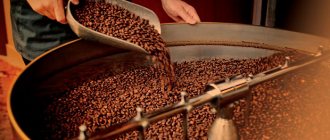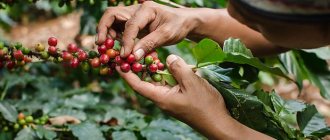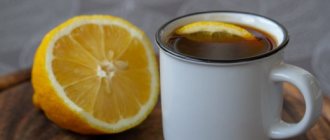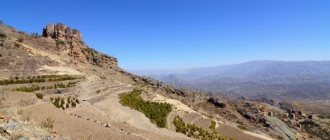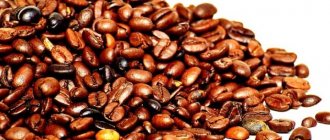What is a coffee fruit (coffee berry)?
The coffee fruit is a stone fruit that grows on the coffee tree.
It is often called by other names such as coffee cherry or coffee berry.
The fruits are usually small and green, but turn dark red or purple as they ripen. The coffee bean is found inside the fruit and is technically classified as a seed.
During coffee production, the coffee beans are extracted and the fruit is usually discarded.
However, thanks to new research into the potential health effects of coffee fruit, it is now gaining popularity as a dietary supplement and ingredient in beverages.
Conclusion:
The coffee fruit is the fruit of the coffee tree. Although they were once discarded during coffee production, they are now used in supplements and beverages.
How coffee is grown
Growing coffee trees requires special conditions with sufficient heat and moisture; each adult representative needs about 7-10 liters of water per day. That is why favorable conditions for them are the equatorial and tropical regions of Central and South America, Africa, Oceania and Asia. There are two main types of coffee - Arabica and Robusta, although there are about 80 varieties of trees.
Arabica coffee beans are considered the most aromatic and are used to produce the best blends for espresso and other drinks. Robusta is less aromatic and more bitter, its cost is much lower than Arabica. Arabica beans are larger than Robusta, their size varies from 6.5 mm to 8-9 mm. The price and taste of the future drink depend on the size. If the grain is larger than 7 mm, it is considered large. This means that the berry from which it was obtained had a high degree of ripeness. Coffee made from such beans will have a bright aroma due to the large amount of essential oils. The smallest grain has a size of 4-4.5 mm. This is low-grade coffee, often classified as substandard.
Millions of bags of grain are harvested from coffee plantations, with about 80% of the goods being exported
To grow a coffee tree from beans and get the first harvest, it will take about 4 years and a lot of effort. In the most favorable regions, 3-4 harvests are harvested per year. The coffee tree blooms with small white flowers, in place of which berries with two grains inside later appear - this is coffee. On most plantations, ripe red berries are collected by hand throughout most of the year. About 1500-2000 kg of berries are collected from one tree, from which about 500 g of grain will later be obtained. On one tree you can simultaneously see flowers, buds, green and red berries.
In order for coffee to acquire the familiar look and aroma, it is collected by hand, dried under natural conditions, crushed and a number of other manipulations are carried out before it is ready for roasting and grinding. As a result, the coffee berry is freed from the shell and sweetish pulp, leaving only the most valuable thing - the grain. The structure of the berry is two grains, consisting of several shells, fruit pulp and an outer shell. The structure of the berry is hard, so it is not eaten.
Beneficial properties of coffee fruit
The coffee fruit may have several health benefits.
High levels of antioxidants
Coffee fruit is rich in beneficial antioxidants and polyphenols.
Antioxidants help neutralize harmful compounds called free radicals, which can otherwise contribute to cell damage and chronic disease over time ().
In particular, fruits are rich in antioxidant compounds such as rutin and chlorogenic, protocatechinic and gallic acids ().
One small study of 20 athletes found that taking 800 mg of coffee fruit extract per day for 4 weeks improved antioxidant status ().
Similarly, older test-tube and animal studies have shown that the extract may improve immune function and slow the growth of cancer cells, possibly due to its high antioxidant content (, ).
Please note - further research is needed to examine how the antioxidants in coffee fruit may affect human health.
Also keep in mind that the processing method can significantly affect the antioxidant content of the coffee fruit. For example, one test-tube study found that the antioxidant activity of extracts was up to 25 times higher than that of powders ().
May Benefit Brain Health
Promising research shows that the coffee fruit may help protect brain function and slow down the signs of aging.
For example, one study of 71 older adults with mild cognitive decline found that drinking coffee fruit extract for 28 days significantly reduced reaction time ().
Another small study found that taking 100 mg of coffee fruit concentrate increased levels of brain-derived neurotrophic factor (BDNF)—a type of protein essential for the survival and growth of neuronal cells in the brain—by 143% in just 2 hours (, ).
Additionally, people with Alzheimer's disease tend to have lower levels of BDNF, according to a review of 15 studies. Therefore, coffee fruit concentrate may play a role in controlling or treating this disease ().
However, more research is needed to better understand the potential benefits of coffee fruit for brain health.
May promote weight loss
Although research on this topic is limited, some studies suggest that the coffee fruit and its compounds may promote fat burning.
For example, in one test tube study, coffee fruit extract promoted the destruction of fat cells while inhibiting the production of new fat cells ().
Coffee fruit is also rich in chlorogenic acid, which has been studied for its ability to promote weight loss and accelerate fat burning.
In one 6-week study in mice fed a high-fat diet, chlorogenic acid prevented weight and fat gain ().
Likewise, in a 12-week study of 150 overweight people, drinking coffee fortified with chlorogenic acid significantly reduced both body fat and belly fat compared to the control group ().
However, keep in mind that current research is largely limited to test tube and animal studies that evaluate the effects of highly concentrated extracts. Ultimately, more research is needed to determine how coffee fruit consumption may affect body weight and fat loss in humans.
Conclusion:
Coffee fruit is rich in antioxidants and may benefit brain health and help you lose weight. However, further research in humans is needed.
Content
- 1. History
- 2 Types of coffee trees 2.1 Arabica
- 2.2 Robusta
- 2.3 Other types
- 6.1 Roasting
- 10.1 Cardiovascular system
- 12.1 Famous paintings depicting drinking coffee:
Potential harm and contraindications
Although research regarding the long-term safety of coffee fruit is still limited, it is generally considered safe when consumed in moderation.
In one animal study, coffee fruit was well tolerated and did not cause any side effects when administered to rats, even at relatively high doses ().
Just keep in mind that coffee fruit contains caffeine. While the exact amount varies depending on the specific product, dosage, and form, most products contain about 5–20 mg of caffeine per serving ().
This is significantly less than regular coffee, which typically contains about 96 mg of caffeine per cup (240 ml). However, if you are sensitive to caffeine or limit your caffeine intake, this is still a factor to consider ().
Conclusion:
Coffee fruit is generally safe when consumed in moderation, but keep in mind that each serving contains a small amount of caffeine.
Methods for preparing the drink
Turkish coffee
Ground coffee in a bag for brewing in cups, similar to tea bags
See also: Coffee maker
Turk
(cezva) - utensils in the form of a ladle for brewing coffee, including Turkish (oriental) coffee. For this method, the finest grind of coffee beans is used.
French press
— a device in the form of a cylindrical vessel (flask) with a piston-filter. Ground coffee is poured into a flask, poured with hot water and left for 3-5 minutes, after which the piston of the French press is lowered and the finished drink is poured into cups.
Filter coffee
prepared using various types of filters. Ground coffee is poured onto the filter and poured with hot water. Under the influence of gravity, water seeps through the coffee powder and the finished drink flows into a vessel located under the filter. To automate the filter coffee preparation process, a drip coffee maker is used.
Geyser coffee maker
- a device into which water is poured, coffee is poured into a special compartment and placed on a heating surface (stove). The drink is obtained by passing water rising under steam pressure through a compartment containing ground coffee.
Capsule coffee maker
Espresso coffee
prepared in an espresso coffee maker. Coffee is poured into a portafilter, compacted with tamper and placed in the coffee maker group. Water under pressure of 8-10 bar seeps through the coffee powder and the drink flows into the cup. This method of preparation is common in catering establishments (cafes, etc.).
Usage
Coffee fruits are widely available in health stores and pharmacies. They can be found in several forms, including liquid extracts, tablets, and capsules.
The fruit is also often added to supplements designed to improve brain health and energy levels, usually along with a mixture of other fruit extracts.
Research suggests that doses of 100–800 mg per day may be safe and well tolerated. However, there are currently no official recommended dosages for these supplements (,).
It's also worth mentioning that coffee fruit is sometimes found in drinks such as juice blends, and is also used to make coffee cherry tea (also known as cascara), a type of herbal tea brewed from the dried rinds of the coffee fruit.
They are also added to some skin care products and applied topically to reduce inflammation and improve skin texture. However, more research is needed to evaluate how coffee fruit may affect skin health.
If you have any health problems or are taking medications, be sure to talk to your doctor before taking coffee fruit.
Conclusion:
Coffee fruit is widely available in supplement form. They are also found in many drinks, including juices and herbal teas, and are sometimes added to skin care products.
Coffee in art and literature
Famous paintings depicting drinking coffee:
Konstantin Makovsky. “In the Cairo Coffee House”, (1872)
Edvard Munch. "At the Coffee Table", (1883)
Ernst Ludwig Kirchner. "Women Drinking Coffee" (1907)
Famous phrases from Russian literature mentioning coffee:
I drank coffee today and without any pleasure. – A.P. Chekhov, "Defenceless Creature".
“I haven’t had coffee yet,” answered the cat, “how can I leave?” – M.A. Bulgakov, "The Master and Margarita"
Summarize
The coffee fruit is the fruit of the coffee tree.
Research shows that it is rich in antioxidants and may improve brain function and help burn body fat.
It is available in several different forms and is often taken as a supplement or added to herbal teas and juices.
However, research on the safety and long-term health effects of coffee fruit consumption is limited, so be sure to talk to your doctor before taking coffee fruit supplements.
Kopi Luwak coffee
The Kopi Luwak or Cape Alameed variety, produced in Asia (Indonesia, Philippines, southern India), is the most expensive coffee
, since in order to acquire a special taste it must pass through the gastrointestinal tract of the musang (or Asian palm civet) - a small animal of the civet family. Without the last link, the taste and aroma of this coffee are very mediocre.
However, it is known that “Taiwanese specialists” from the slopes of the Formosan Mountains recently proposed a cheaper analogue of Kopi Luwak coffee - “Monkey Coffee”, with the same original method of processing raw coffee beans only “with the help” of monkeys.
↑ up
How Arabica grows
Arabica can be compared to a beautiful girl - the more beautiful, the more capricious. But if in human society there are unobstinate beauties, then Arabica is very whimsical. Growing a crop is not easy, and the better you care for it and observe all growing conditions, the tastier the drink will be from its grains.
The main requirement is the complete absence of frost. Even a slight frost will kill tender plants or permanently prevent them from bearing fruit. Extreme heat is no less harmful. When the air temperature rises to +46°C, they are deprived of the opportunity to bloom and produce crops and become ill. There are several other conditions for the favorable existence of the species:
- average daily temperatures in the habitat +15 - 24°C;
- sufficient air humidity, regular heavy rains, the optimal amount of precipitation during the year is 1400 - 2000 mm;
- deep, fertile soil with an abundance of minerals (preferably volcanic), if there are no such natural conditions - repeated year-round fertilization;
- disease prevention and pest control, regular treatment of plantations with pesticides and fungicides.
From the moment of flowering until the harvest of ripe fruits, 6–7 months pass. Depending on the alternation of rainy and dry seasons, 1 or 2 harvests are harvested per year. Optimal living conditions for Arabica are mountainous areas at an altitude of 900 - 2100 m above sea level, even better 1400 - 2500 m. There is always enough moisture on the slopes, there is no scorching heat. The higher the height at which coffee beans are ripened, the milder their taste and lower the caffeine content. Weather conditions and soil quality have a major impact on the taste of the future drink.
Wild, uncultivated coffee trees grow up to 10 m. This height reduces yield and creates problems when picking berries. Therefore, on plantations they are pruned at a level of 120 - 500 cm, the branches grow in width, the tree becomes spreading and occupies a large area. After planting, Arabica begins to bear fruit in the second or third year of life, the fruitful period lasts 20 - 25 years, and the lifespan is 70 years.
